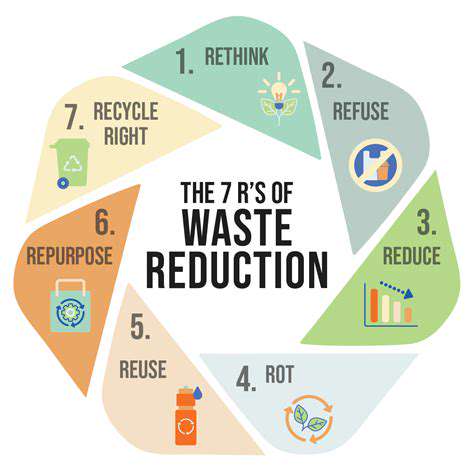How to Make Your Home More Sustainable
Reducing Your Carbon Footprint Through Home Modifications
Improving Energy Efficiency
Implementing energy-efficient home modifications is a cornerstone of reducing your carbon footprint. Swapping out older, less efficient light bulbs for LED options can significantly lower your energy consumption, and these bulbs last much longer than traditional incandescent bulbs, further reducing waste. This seemingly small change has a cumulative effect, making a notable difference in your overall energy bill and environmental impact.
Insulating your home properly is another crucial step. Proper insulation reduces heat loss in winter and heat gain in summer, drastically decreasing the need for heating and cooling. This not only saves money on utility bills but also minimizes the reliance on energy-intensive methods of temperature control, directly contributing to a smaller carbon footprint.
Smart Thermostat Integration
Utilizing a smart thermostat is an intelligent way to optimize your home's temperature control. These devices allow you to program your heating and cooling schedules based on your daily routine and even adjust settings remotely. By automating your home's temperature, you can avoid unnecessary energy consumption when you're away or asleep, resulting in substantial energy savings and a smaller carbon footprint.
Sustainable Building Materials
Choosing eco-friendly building materials plays a vital role in creating a home with a smaller environmental impact. Opting for materials made from recycled content or sourced sustainably reduces the demand for raw materials and minimizes the environmental damage associated with traditional construction methods. For example, using reclaimed wood or bamboo instead of newly harvested timber can significantly lower your carbon footprint during construction.
Water Conservation Strategies
Conserving water is just as crucial as saving energy. Installing low-flow showerheads and faucets can significantly reduce water usage, minimizing strain on water resources and the energy required to treat and deliver water. Simple changes like fixing leaky faucets can also make a substantial difference over time, leading to significant water savings and a reduced carbon footprint.
Renewable Energy Sources
Implementing renewable energy sources within your home, such as solar panels, can drastically reduce your reliance on fossil fuels. Harnessing solar energy to power your home reduces your carbon emissions and lowers your energy bills. This transition to renewable sources not only benefits the environment but also positions your home as a sustainable model for future living, helping to reduce your carbon footprint considerably.
Landscaping for Sustainability
Your landscaping choices can also contribute to reducing your home's carbon footprint. Planting native plants requires less water and maintenance, minimizing your impact on local ecosystems. Choosing drought-tolerant species further reduces water usage, contributing to water conservation and a smaller overall carbon footprint. By creating a sustainable landscape, you're reducing your environmental impact and creating a healthier living space.
Waste Reduction and Recycling Strategies

Waste Reduction Strategies
Implementing effective waste reduction strategies is crucial for minimizing environmental impact and conserving resources. These strategies encompass a wide range of actions, from individual consumer choices to large-scale industrial practices. By prioritizing waste reduction, we can significantly lessen the strain on landfills and the need for resource extraction. This approach also fosters a more sustainable future, promoting a circular economy where materials are reused and recycled.
One of the most effective strategies is promoting the concept of the reduce, reuse, recycle hierarchy. This emphasizes the importance of minimizing waste generation at its source, followed by reusing items whenever possible, and finally recycling materials for secondary use. This tiered approach ensures that we prioritize the most sustainable options first.
Recycling Programs
Robust recycling programs are essential for diverting waste from landfills. These programs should be widely accessible and clearly communicated to the public. Educating individuals about proper waste sorting and material types is crucial to ensuring successful recycling efforts. This involves clear labeling on recycling bins and materials, as well as accessible educational resources.
Different materials have different recycling processes and requirements. For example, paper, plastic, and glass have varying levels of recyclability depending on the specific types and contamination levels. Proper sorting and handling are vital to maintaining the quality of recycled materials and ensuring efficient processing.
Composting Initiatives
Composting organic waste is a powerful way to reduce landfill burden and create valuable nutrient-rich soil amendments. Composting programs can be implemented at various levels, from individual households to large-scale community initiatives. This practice reduces methane emissions, a potent greenhouse gas, released from landfills and promotes the growth of healthy soil.
Consumer Responsibility
Consumer choices play a significant role in waste reduction. Making conscious decisions about the products we purchase and the packaging they come in can have a profound impact. Choosing products with minimal packaging, opting for reusable alternatives, and supporting businesses committed to sustainable practices are all important steps. By making conscious choices, consumers can contribute significantly to reducing waste at the source.
Industrial Waste Management
Efficient waste management strategies are critical for industries across the spectrum. Implementing closed-loop systems that prioritize material reuse and recycling within industrial processes is crucial. Investing in innovative technologies and processes for waste reduction and recycling within industrial settings is vital. This approach can lead to significant cost savings and environmental benefits by minimizing waste output.
Government Regulations and Policies
Government regulations and policies play a crucial role in promoting waste reduction and recycling. Implementing and enforcing regulations that incentivize waste reduction and recycling can significantly impact waste generation rates. Clear policies and regulations can establish targets for waste reduction, promote the development of recycling infrastructure, and encourage sustainable practices. Such policies also provide a framework for holding businesses and individuals accountable for their waste management practices.








![Best Smart Vacuum Cleaners [2025 Review]](/static/images/31/2025-05/SmartFeaturesandConnectivity3AStreamliningYourCleaningRoutine.jpg)



